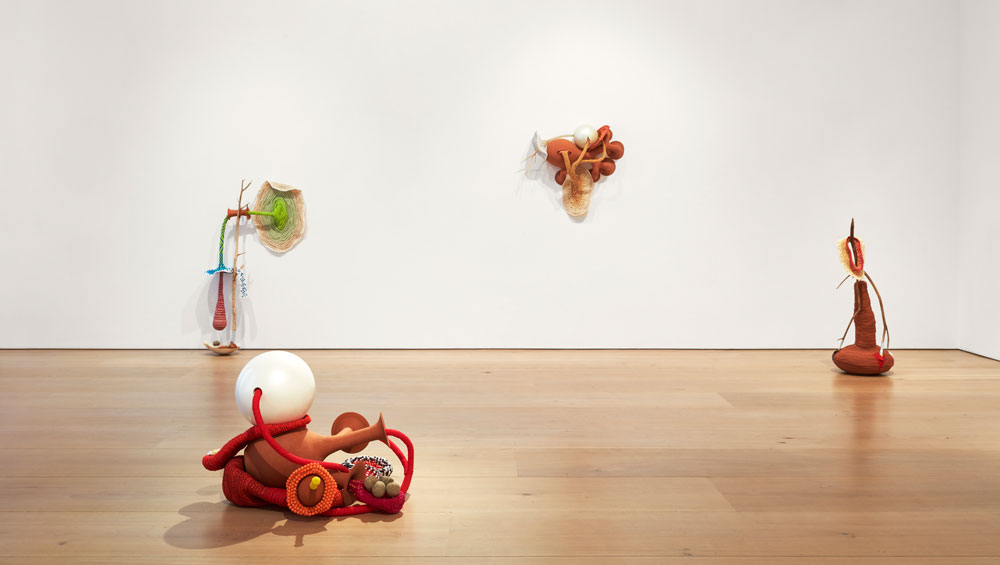
by ANGERIA RIGAMONTI di CUTÒ
The sculptor and installation artist Maria Nepomuceno (b1976 Rio de Janeiro) presents her visceral, pulsating, voluptuous assemblages at Victoria Miro Mayfair. Permeated with an abundance of cultural references, her hallucinatory creations are suggestive of animal and human body parts, outlandish plants, and extraterrestrial landscapes. She spoke to Studio International about the myriad sources she draws on, in keeping with Brazil’s remarkable cultural diversity, as well as the fundamental importance of crafting an enveloping atmosphere of vital energy in her work.
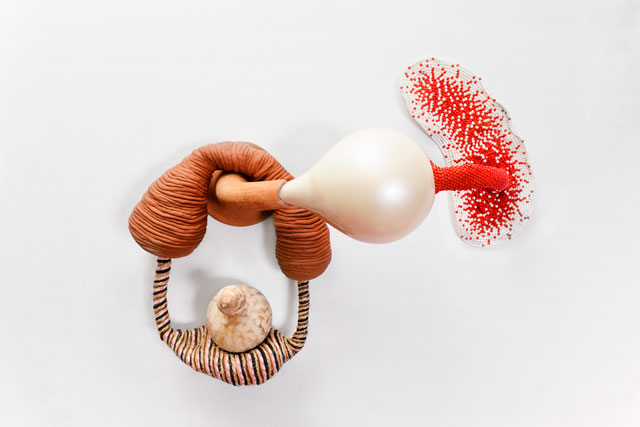
Maria Nepomuceno. Untitled, 2016. Ceramic, ropes, beads, cabaça, fibreglass and resine, 70 x 50 x 30 cm (27 1/2 x 19 3/4 x 11 3/4 in). Courtesy the Artist and Victoria Miro, London. © Maria Nepomuceno.
Angeria Rigamonti di Cutò: You studied industrial design at the University of Rio. Although you do use some industrial materials in your work, it seems surprising that you chose that particular type of training considering that your sculptures almost seem the antithesis of the industrial, and use traditional, handmade techniques such as straw weaving?
Maria Nepomuceno: I had an interest in objects, and perhaps a sculptural way of thinking that I didn’t immediately recognise. At the time, I used to paint rather than make three-dimensional objects but I thought that learning about the materials of industrial design would be interesting and I decided I’d like to do product design. But during the process of studying I realised it wasn’t for me, though having access to workshops and tools gave me an opportunity to work with wood, steel and acrylic. I then decided to pursue theatre design and that, too, was interesting in the way it allowed me to understand space and light. Even though I knew it wasn’t something I wanted to do for the rest of my life, I think I gained something from both these strands in my later work.
ARC: Can we talk about some of your Carioca influences, who include Lygia Clark, Hélio Oiticica, Lygia Pape and, later, Tunga and Ernesto Neto? I find it interesting that some of the older of those artists began in the initially quite cerebral realm of concrete and constructivist art and then evolved into something radically more participatory and body-centred. Do you think the mind had become too privileged, and was that shift something that appealed to you about some of those artists?
MP: I think that neo-concretism turned into a desire to talk about feelings, sensations and the relationship with the body and nature rather than thinking only about the shapes and colour that concrete art was concerned with. I think that I have certainly been influenced by many Carioca artists. As you said, Lygia Clark, Hélio Oiticica and Ernesto Neto, but at the same time my influences are very varied. From the moment I got into the School of Visual Arts [at Parque Lage, Rio] at the age of 14, painting influenced me a lot. At 15, I had the opportunity to travel and see work by Matisse, Yves Klein and many other European artists.
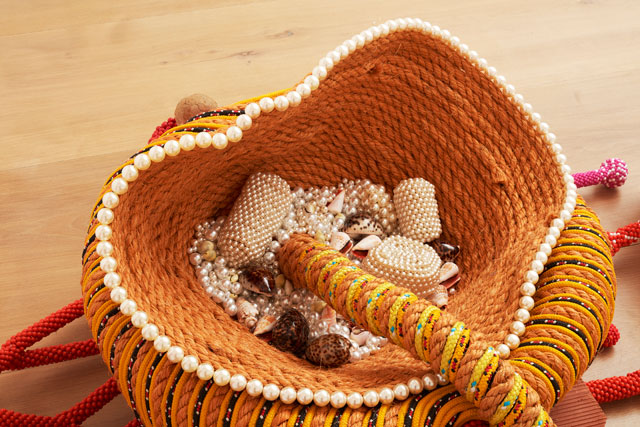
Maria Nepomuceno. Untitled, 2016 (detail). Ropes, beads, ceramic and braided straw, 200 x 100 x 90 cm (78 3/4 x 39 3/8 x 35 3/8 in). Courtesy the Artist and Victoria Miro, London. © Maria Nepomuceno.
ARC: You use a kind of Klein blue quite a lot in your work?
MP: Yes, that‘s true. But within Brazilian art, I was influenced by very different generations and styles. For example, I’m very touched by the work of the sculptor Celeida Tostes, who worked with clay, or Mestre Didi who was part of the Candomblé religious tradition of Bahia. I love the materials he worked with and the fact that he never spoke about his work because there was a mystery about it. I also admired the amazing sculptor Nelson Eddy, and Sérgio de Camargo. But my uncle, too, who was a painter, affected me, as did op and kinetic artists Victor Vasarely and Abraham Palatnik. I was in love with the work of Jésus Rafael Soto and even Alexander Calder, who used the idea of movement in his sculpture. I even liked lesser-known artists whose work I saw at home, such as Marília Kranz. We had a painting of hers that influenced me a lot, in the way that things that are in your house do. Then I discovered Georgia O’Keeffe and thought that Kranz must have been influenced by her. That was where I got my passion for colour that certainly affected my approach to art. Miró, too. There are really many artists whose presence I feel in my work, although there’s a re-processing. Sometimes I’ll say: “I was thinking about Magritte when I did this work”, and people can’t see it at all. But I certainly think there’s a touch of surrealism in the way I use objects, for example the paintbrush that becomes a branch.
ARC: Going back to Lygia Clark, she went on to adopt a therapeutic, even psychoanalytical, mission in her later works such as Structuring the Self. Do you ever envisage a therapeutic role for your creations?
MP: No, I don’t think so, at least not in the way that she applied it to her work. What was important to me with Lygia Clark was the way she created a relationship with the body.
ARC: You also spoke of Oiticica being important to you, and in his case there was also a strongly political slant to his environments that critiqued the military regime of the time. Do you think that art can have that strong political impetus now that it’s so bound up in a market system?
MP: I think all art is intrinsically political, but there’s no longer necessarily an obvious political statement. But as the world becomes a more difficult place in which to live, people increasingly want to become more involved, it’s becoming more important. In my case, though, it’s not something I want be at the forefront of my work. I want to create a place where people can be suspended in time, in an environment where they can breathe and lose the notion of where they are, or what they’re doing or what the piece is for. I want to create an atmosphere that absorbs you, a place that’s about affect, ancestral connections and the future, about time, living and feeling alive, vital energy, that’s what I’m trying to create.
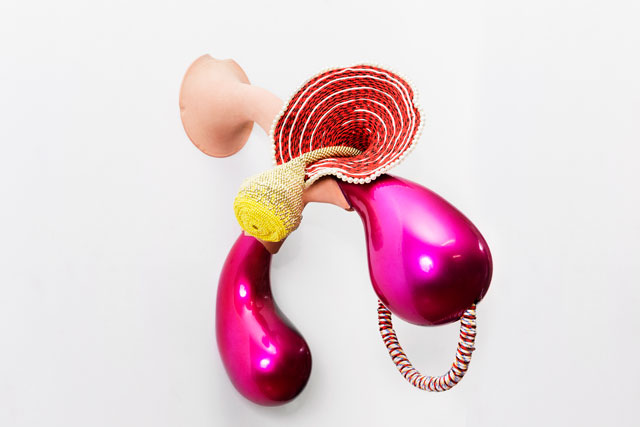
Maria Nepomuceno. Untitled, 2016. Ropes, ceramic, beads, fibreglass and resine, 67 x 59 x 30 cm (26 3/8 x 23 1/4 x 11 3/4 in). Courtesy the Artist and Victoria Miro, London. © Maria Nepomuceno.
ARC: In that respect, although your sculptures can be sunny and joyful, at the same time I find they have an aspect of unease. There’s something about these invasive, triffid-like organisms with an apparent life of their own that can feel faintly disquieting. Is this something you consciously want to evoke? I know you’ve mentioned that your use of rope refers to the umbilical cord following a traumatic experience in your pregnancy. So are you also thinking about a darker side of that vital energy?
MP: Not a dark side. I think that the shape of the spiral I use is an analogy for the spirit of essence of the work. The construction of the piece is always based on a spiral: the stitching is in a spiral and I like to use this form to represent a sense of the work that alternates between inside and outside; it goes somewhere deep and far, to our origins and the essence of our life. The spiral also moves outwards, it’s open and expands towards the infinite. So I don’t think there’s darkness, but there is a void in the work, something that sucks you in, and this contraction and pulsation is important for me.
ARC: In this show, a recurring element that’s incorporated into the sculptures is a paintbrush that transforms into a branch, something you linked earlier to a surrealist note in your work. What are you suggesting about the relationship between painting and sculpture?
MP: Yes, I am forming a bridge between painting and sculpting. In a way, it’s also about the frustration of not painting, and missing painting and using its materials. When I go into a paint shop, I go crazy: I miss the sensorial quality of those materials. These brushes have been coming into the work for the past three or four years and are in development. At first, it was just a brush, then slowly they grew in scale and I began making them in the studio. Then they began to create branches and develop a life of their own. It’s also a structural part of the sculpture that contains both hard and soft parts, as well as desire for verticality since the works are partly lazy and horizontal, so this combination supports the work in a physical and metaphorical sense.
ARC: Although they’re not present in this show, I’m interested in your use of the hammock, an incredibly important object for the indigenous cultures of Latin America – the Brazilian anthropologist Luís da Câmara Cascudo wrote a book on their history and importance in all phases of life. Why are you so drawn to this object? Is it again something to do with the tension between opposing ideas – the hammock is a place of rest, but at the same time it’s taut and suspended?
MP: There are many aspects of hammocks that impress me. The first time I used one was in a show at the Galerie Karsten Greve in Paris in 2008. The hammock is the most important object for indigenous cultures. It’s their house: if they travel, they take their hammocks with them so that wherever they are they feel at home. There are also these aspects of tension and relaxation, and there’s also a contradiction about an object that’s in repose but also moves at the same time. It’s about affection, too. This is an object that holds you and in which you feel protected. So the hammock embodies many characteristics that I’m trying to bring to my work, this tension between opposing forces, the hard parts and the soft parts. I’m always looking for this limit between the work feeling ludic and visceral.
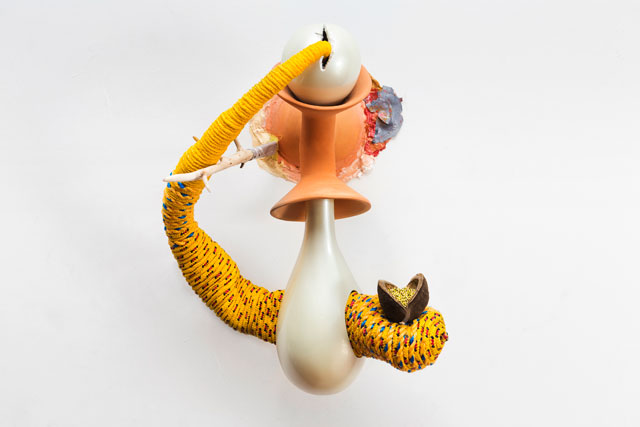
Maria Nepomuceno. Untitled, 2016. Ceramic, ropes, cabaça, fibreglass and resine, 40 x 30 x 25 cm (15 3/4 x 11 3/4 x 9 7/8 in). Courtesy the Artist and Victoria Miro, London. © Maria Nepomuceno.
ARC: Other than your sculptural works, you also did a performative and participatory work, the Amor Ball, which you took to Huni Kuin tribe of north-west Brazil. You got the men and women to blow up this ball and interact with it. How did they respond and how did they view and experience this kind of performance?
MP: I’d like to speak a little about how this idea began. It was really something in my blood. My great-grandmother was indigenous; she was from Ceará in the north-east of Brazil. I have a very indigenous face that I must have inherited from my ancestors and it’s funny because no one else in my family has such indigenous features and such black hair. I’ve had an awareness of this since I was a child, and also my uncle who taught me to paint, loved to paint indigenous people. He gave me a set of 80 cards with indigenous people from many different tribes, showing them in scenes of everyday life, fishing, sewing, braiding. My uncle died when I was 15 and he left me all his painting materials and these cards. They were really precious to me and I loved looking at them.
So the images came to me in a very affective way, it wasn’t a question of looking into my origins or understanding Brazil in general. I decided I would go to this tribe and, as part of a prize I won, it was agreed that I would make a film about the experience. I arrived with the intention of making this film but tried to think of something that would involve the people. I devised four ways of involving them. First of all, I took them a hammock, because there is always a gift-giving ritual, and there was the symbolic idea of the object being returned to its origins. I made one of my hammocks and the reaction was amazing. They loved the hammock; it was a very playful one, with tentacles, like an animal. There’s a good text written by an anthropologist on this work.
Then I proposed that we sew a work made with beads as a group. They used very small beads and I used much larger beads, though in the same colour. You could see how the experience was very different for them than it was for me. I sew very fast while they worked the small beads very slowly. I then proposed that four women should weave a basket together. They usually do this by themselves and laughed a lot working this way, but in the end found they could work together, and hearing their conversation during this process was such a pleasure.
The last activity I devised was the Amor Ball. When I had used the ball before in other settings , I had it blown up mechanically. But the tribe had no electric energy so I had to think up another way of blowing up the ball. I made nine openings so people could inflate it themselves. It became a really beautiful ritual and, rather than simply being an object, the ball became something that contained people’s breath, so the material and the sense of the work really changed for me. They are very playful, good-humoured people and really enjoyed it. They also like to have men and women work separately, and would even divide the playtime with the ball along those lines so that it almost became a competition between the men and women.
It was a wonderful experience and doing the work like this enabled me to have a relationship with the people while creating a work that would mean something to them and their lives. I didn’t have to explain much, and in their culture the idea of explaining things doesn’t really exist, they find it boring. Afterwards, other artists began to develop a relationship with the Huni Kuin people and work with them.
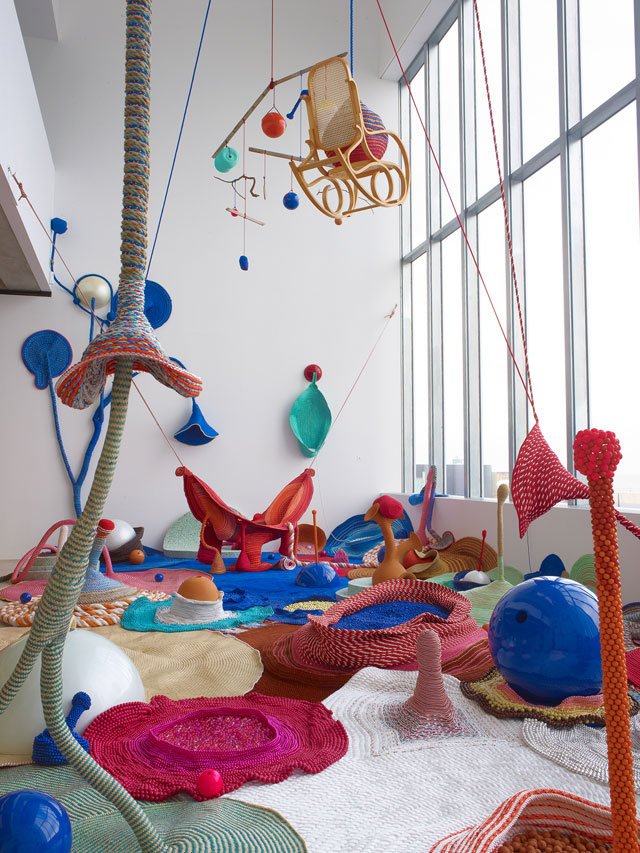
Maria Nepomuceno, Tempo para Respair (Breathing Time), 14 September 2012 – 17 March 2013, Turner Contemporary, Margate.
ARC: Finally, I’d like to ask you about the very varied contexts you’ve exhibited in. Other than the classic white cube urban galleries, you have also exhibited at Turner Contemporary Margate, where again you worked with teams of locals. In Rio, you created the Gentil Gallery wall project that brought the work out of the gallery on to the street, while at the brutalist Barbican in London, perhaps the most apparently unlikely setting for your work, you installed the piece Cosmic Teta. How much of an effect does the particular site have on the work?
MP: The surrounding space influences my work a lot. As soon as I know what space the work will occupy, it’s impossible not to think about it. I want to dominate the space so I have to understand the space. Even if it’s a very small piece, it has to have the presence to communicate with and dominate the setting.
ARC: Another combination that I found particularly interesting was your intervention at the Eva Klabin Foundation in Rio because, in that instance, your sculptures occupied an existing, very haut bourgeois domestic interior. How did you respond to this surreal confrontation?
MP: I love that place. It was really a challenge, to be able to have the power to make all those references and pieces from different historic periods somehow be submerged in an absence of time. It was as if I was placing everything into a black hole where it would be suspended in time. I did one room in blue, a colour that for me was about spirituality, and I used it to counteract all the existing objects and carpets in the room that were very red and carnal. I wanted to oppose that with a feeling of transcendence.
• Maria Nepomuceno: Sim is at Victoria Miro Mayfair, London, until 14 January 2017.